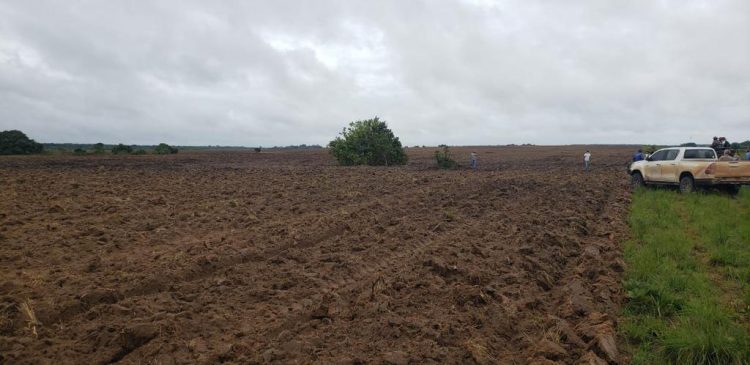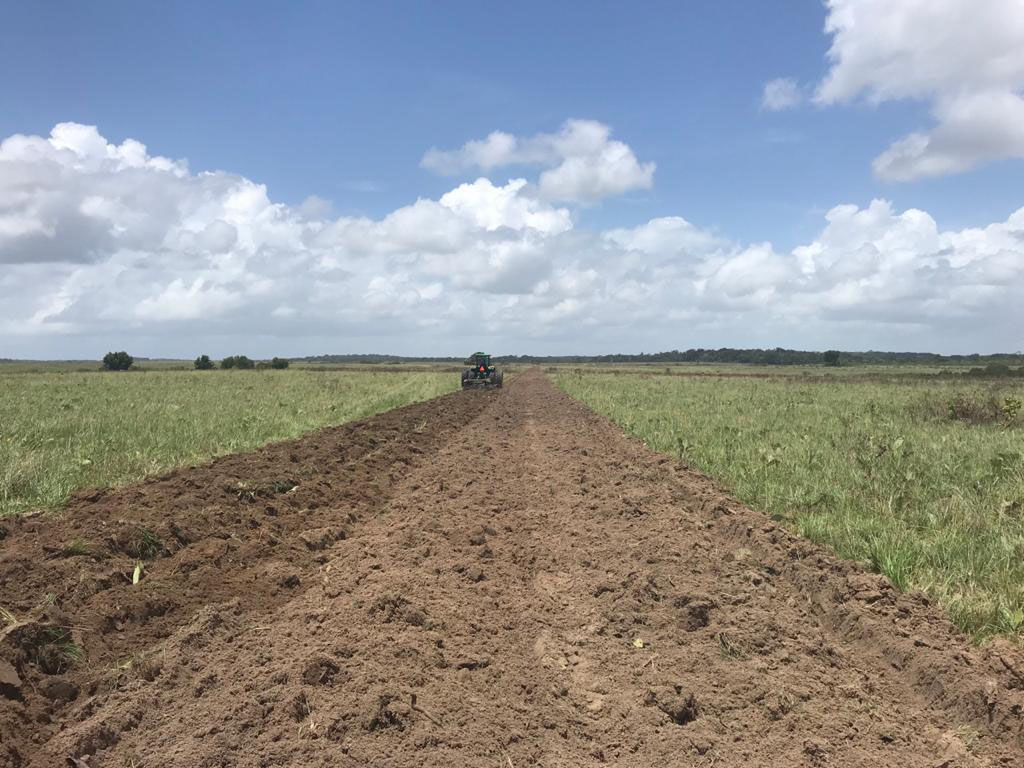Upbeat about being part of a project to produce corn and soya bean locally for livestock feed, Chief Executive Officer and owner of Guyana Stockfeeds Inc, Robert Badal says the initiative will significantly decrease reliance on imports and ensure prices, especially for poultry, remain constant.
And as some 250 acres are being prepared in Tacama, Region 10, for a trial crop scheduled for planting next month and reaping in September, it is Badal’s hope that the project grows significantly to the point where other local investors will come on board so as to get this country to the stage where it becomes the Caribbean’s premier supplier of poultry feed.
“It is a public-private partnership and our mission now is to arrive at the best variety and yield to ensure it makes economic sense, which I am very optimistic that it would,” Badal told the Stabroek News in an interview.
“We import probably about 100 thousand tonnes of grains per annum of corn and soya. These would normally be sourced from the US. Our conditions here in the Inter-mediate Savannahs present a significant opportunity for the local production of corn and soya in the sense that we have extensive acreage for large scale production. Growing our grains will enhance the competitiveness of our poultry production; presenting us with the opportunity to export processed chicken feed throughout the Caribbean,” he added.
Last month, the Ministry of Agriculture (MoA) announced that six local companies had joined forces to undertake a “massive project” that could place Guyana on the path to becoming self-sufficient in corn and soya bean over the next few years.

The consortium which consists of Guyana Stock-feeds Ltd, Royal Chicken, Edun Farms, SBM Wood, Dubulay Ranch, and Bounty Farm Ltd, along with the Brazilian-owned NF Agriculture, plans to produce soya bean and corn for both the local and the regional markets.
So far, the MoA release had stated, the team has engaged bodies like the Guyana Lands and Surveys Commission (GLSC), and the Guyana Office for Investment (G-Invest).
Once given the green light, cultivation is expected to commence before the end of this year.
Giving an update on the project yesterday, Minister of Agriculture Zulfikar Mustapha said that the partnership would see government investing in the public infrastructure to make access easier and it is hoped that the investors would undertake the financial part in the execution of the project.
He added that preparations were currently ongoing and that some 250 acres of land for the commercial trials were being prepared.
The Office of the President later in the day shared an update on Facebook stating “preparations are moving apace with the 2nd cut being done on the 250 acres of land for the commercial trials for both corn and soya beans.”
“The seeds will be planted in June 2021 with harvest in September 2021,” it added. The Office of the President page showed a video clip of a tractor with tiller preparing lands while the President’s page shared eight photos of different shots of the lands prepared.
The Minister of Agriculture explained that the project was birthed as a collaborative initiative among the businessmen as government partners with them to put in the necessary infrastructure. “It is a collaboration where government gives the infrastructure and they roll out the agriculture project. Already, we have done site visits and have seen the 18 kilometers of road to the site. We collected soil samples to be tested to know what specifications of the road we should do. We are aggressively pursuing this and hopefully by June they can start planting.”
He assured that government was “committed” to playing its part and that the MoA will use monies from the $500 million allocated in the 2021 Budget to “do these works” so that the project can be off the ground in the timeframe scheduled.
Invite
With Tacama in Guyana’s Intermediate Savannahs being the lands for the trial crops, Mustapha disclosed that if successful, government would be looking to invite additional investors for various other agricultural initiatives.
“We are moving ahead and we are looking at other investors. This is the first time we are embarking on this type of crop but we are optimistic. Guyana has a market for the crop and we can tap into the market here and on a large-scale basis can look at supplying Northern Brazil and the Caribbean,” he posited.
Already, the Agriculture Minister has met with all of the investors and they have gone through discussions on the technicalities and execution of the project. He said that he has also met with Brazilian officials and earlier this week did a comprehensive presentation on the project plan.
Technical officers from his ministry, according to Mustapha, will have follow up meetings with officials where they will discuss the possibility of refining a number of products. “I am hoping we can give them some technical data and they can choose what they want to do.”
Investors from Dubai in the United Arab Emirates, have also signalled their interest in cultivating corn and soya bean locally.
It is the Irfaan Ali administration’s hope that the project’s success will see feed being later exported to Caribbean sister nations as Mustapha pointed out that sometimes Belize is unable to supply the region with feed and other crops.
“There are lucrative markets for corn and soya because the entire poultry [sector] is dependent and the aquaculture industry, that will soon take off [and will] have to be looked at too,” Mustapha said.
Badal agrees that agriculture diversification was the way to go and said that the current soy and corn project could not have come at a better time.
“The timing for this project could not have been any better because of the fact that prices for both corn and soya have escalated more than 200 per cent in the last six months and the world over is a bit nervous about the supply and the prices of these commodities,” he shared.
“So we have the government putting in the infrastructure and us working fervently on the trials to evaluate the yields so that we can get the best variety to be used and the objective is that our local production must be internationally competitive. Everything falls together,” he explained.
For his company’s part, he said that they will pool equity in the cultivation process. While Guyana Stockfeeds will also invest in the harvesting, storage and processing of the grains, Badal said that a mechanism has not yet been worked out on the ratio split. This is because the focus now, he said, is on getting the best yields during the trial process.
“As it relates to Guyana Stockfeeds, we will participate in the form of equity in the cultivation of soy and corn as well as we will invest in harvesting and storage and processing of the grain. We will have a company that will do the planting. All the poultry farmers will have an equity position but additionally we will be interested in buying the grains, processing it into a form that is suitable for poultry production. So we haven’t worked out yet the financial parts that you asked about. Once knowing what the yield is and getting the best, we can have a more formal arrangement in extending the cultivation into large-scale production. All those things you asked about will have to be worked out down the line. Once we arrive at the trials and the yield and the economics, then we can get into the other arrangement to facilitate large scale production, processing and other aspects which will flow from that,” he explained.
“We will all pool our resources to get [to] that because it is a joint effort that benefits the industry. The rest of the details we have to work that out. Don’t focus too much on that aspect. G-Invest has a role and so has NAREI because it is a joint government/private sector approach,” he added.
He believes that while soya and corn had been contemplated before for large-scale planting here, direct politics in those projects saw them not take off.
“This approach has more legs in terms that there have been attempts to grow corn and soya for ages. National Service and GuySuCo had their hands into that effort but it never took off,” he noted.
Asked why he believes this time around it will be different and successful, he replied, “This current configuration is a much more effective way of doing things because it takes the politics out of it and the day to day operation but brings the political budgetary support to make it a success. I am optimistic it will be a success.”
Presently, according to the MoA, Guyana’s national feed consumption for the poultry industry is 113,000 metric tonnes annually. Broiler birds consume approximately 100,000 metric tonnes of feed, and layers approximately 13,000 metric tonnes of feed annually. This feed comprises 60% grain (corn & rice), which is equivalent to approximately 68,000 tonnes, and 30% soya bean meal which is equivalent to approximately 34,000 tonnes per year.






